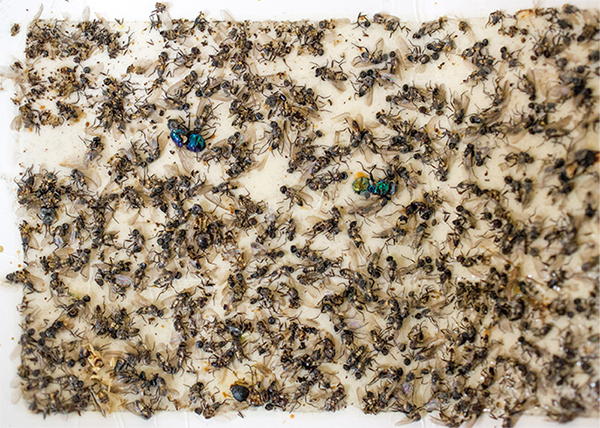By: Anna Berry, B.C.E.
When a client reports seeing insects in their facility, or if the facility is at risk for insects, one of our first steps is to place insect monitoring traps. These traps, when used appropriately, can give us much information about the insects that are present: the species, the area they’re in, even the direction they’re traveling from. But when it comes to choosing an insect monitoring trap, one size does not fit all. Some insects fly, some crawl, some are attracted to light, some are only mobile in their adult stage, etc. Choosing the right trap based on the target insect’s behavior and biology and servicing it appropriately will make identification and inspection easier. This may mean supplementing the current program with temporary traps or permanently adding new devices to manage the new risk that is present.
Insect Light Traps (ILTs)
ILTs are often the default trap for interior adult flying insects. We tend to use them for flies, but their use extends to other groups of flying insects, including stored product pests and stinging insects. If the insect can fly and is attracted to light, an appropriately placed ILT will provide valuable information. But remember that not all flying insects are attracted to light, and some that are attracted to light aren’t attracted to light throughout their entire adult stage.
Fruit flies, for example, are attracted to light right after emerging from pupae, but are not as highly attracted to light later in their adulthood. ILTs may not be an effective monitoring tool for these pests if not placed near their emergence site. Likewise, many stored product pests fly, and while some are highly attracted to light (such as the cigarette beetle), some are not attracted to light at all. There are ILTs that use glueboards to capture flying insects that are attracted to the light, and there are ILTs that electrocute the insects that are attracted. While both are effective at capturing, it will be much easier to identify the species on the glueboard-style ILT. The electrocuting-style ILTs can cause the insect to break into many pieces, making identification challenging or impossible. Also be mindful when choosing an ILT of placement restrictions due to food in commercial accounts.
Tent Pheromone Traps
When we’re protecting food from stored product pests, we often put a tent trap in as a default. Tent traps are great for flying stored product pests, but they won’t catch any crawling stored product pests or those that aren’t strong flyers (such as flour beetles). Additionally, a tent trap needs a pheromone lure added to it (some are sold with the lure embedded). Without a pheromone, there is nothing to attract them to the tent trap. Pheromones are species-specific and not all stored product pests have pheromones that have been commercially synthesized. This means that while a tent trap may give you great information about some stored product pests (such as Indianmeal moths or warehouse beetles), if the right pheromones aren’t present, they’re not going to give you any information at all about those stored product pests that may be present but either aren’t strong flyers or the pheromone is not available for.
Pitfall Pheromone Traps
While tent traps are designed for flying stored product pests, pitfall traps are for crawling stored product pests. We can put pheromones for crawling stored product pests, if available, in the trap; but we also can put kairomone, or food oil, into it. This food oil is not species-specific and can attract insects to the trap. Because these traps are typically placed on the floor, they are often destroyed or lost in commercial environments, so be cognizant of placement and make the client aware of their presence.
Glueboard Monitoring Traps
These traps are great for any arthropod that crawls along a perimeter, such as German cockroaches, spiders, and ants. Placement is key, as the arthropod has to walk along the glueboard to be trapped, so they must be placed in likely travel paths. Flying insects are often caught in these glueboards too, if placed in areas where the insect rests.
Fruit Fly Traps
Fruit flies are a group of small flies attracted to fermentation. Fruit fly traps typically have a liquid lure inside a cup that attracts them. The flies enter through small holes and get caught in the cup. Like all monitoring traps, these won’t control the problem, but will give information about where the infestation is, guiding our inspection and determining a control method.
Species-Specific
In addition to those listed, there are several species-specific traps available, such as bed bug monitoring traps, that only catch the intended species. Because almost all traps listed are intended to capture the adult stage of the insect (an important exception is the insect glueboard monitor, which will capture any stage that comes across the board), use the information they provide to locate areas where juvenile stages are likely to be. No matter the trap selected, it’s only the first step in controlling the problem. These traps will help to identify the insect and guide the inspection, but will rarely effectively control an infestation. Use the information they provide to develop an effective control strategy. If you place a trap and find that you’re not catching anything, consider that the trap is not the right fit for the insect and better options may be available.
Anna Berry, B.C.E., is a technical manager and entomologist for McCloud Services.
This Tech Talk article was originally published in the June 2021 edition of PCT magazine.

